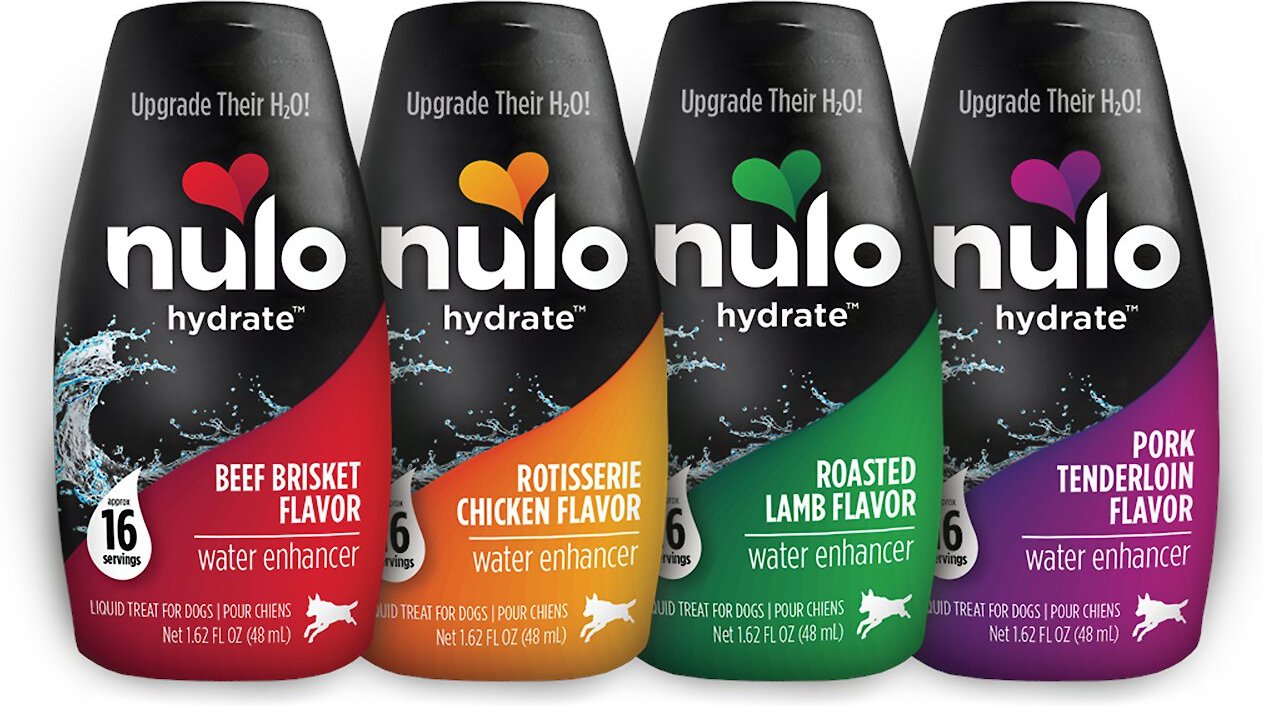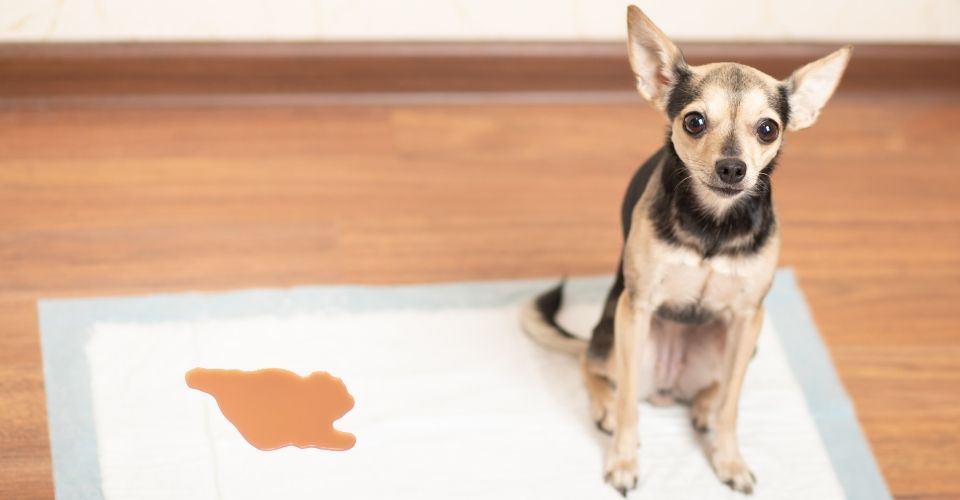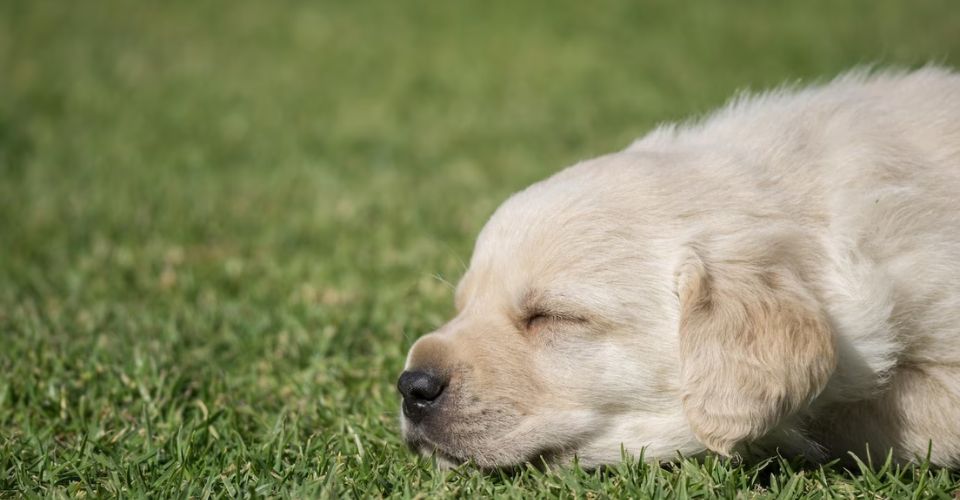When it comes to peeing, animals are no different from us. Just like in human beings, urine speaks volumes about animals’ overall state of health. With dogs being no exception, dog urine’s physical and chemical properties often alter, indicating what could be wrong with their health. The most obvious and discernable among those modifications is the change of color, which occurs mainly due to diseases and inappropriate water levels in the body.
This is where the dog urine color chart may come in handy to make things further simple. It depicts each dog’s urine color against its causes and the remedies, making it effortless for owners to have a picture of their furry friend’s fitness.
Consisting of the seven most likely colors in dog urine, a handy dog urine color chart is presented here, along with a brief explanation of each. You can refer to it whenever you sense that your canine’s pee color is not right and plan your next move accordingly.

Dog Urine Color Chart
Dog urine can exhibit colors ranging from transparent to darker shades of yellow or black. Sometimes, they include atypical colors like green as well. Based on this fact, the dog urine color chart is arranged in shades from lighter to darker.
| Urine Color | Cause | Action |
| Transparent or Clear | Overhydration Diseases related to kidney or liver | MonitoringVet visit |
| Pale Yellow | it’s the normal dog pee color | Rejoice! Your dog is healthy! |
| Dark Yellow | Dehydration Renal issues Liver failure | RehydrationVet visit |
| Brown or Black | Toxins Inflammation Internal bleeding | Vet visit |
| Orange | Jaundice Liver or pancreas issues Medication | Vet visit |
| Red or Pink | Renal problems Inflammation Diet | Vet visit |
| Green | Kidney issues Diet | Vet visit |

Transparent or Clear
Clear urine in dogs indicates two things: either your dog is drinking too much water, or he is suffering from diseases related to the kidneys or liver and cannot filter toxins out of the body properly.
If your dog’s pee is transparent, he is simply overhydrated, and cutting on his water intake should turn his urine color pale yellow; nevertheless, if the void of color persists, simply capture a urine sample and contact a vet soon without hesitation.
Pale Yellow—Normal Dog Urine Color
Pale yellow is the most desirable dog urine color because it indicates health, well-being, freedom from illnesses, and proper hydration.
However, even if your dog’s pee is pale yellow, it is still advisable to keep a check on the color and try to maintain its consistency. As pale yellow is the normal hue in dog urine, any divergence from it might indicate health disorders. Therefore, if your dog’s urine color changes—it becomes dark yellow or bright yellow—and does not return to pale yellow for a long time, you should contact a vet as early as possible.
Dark Yellow Urine in Dogs: Why Is My Dog’s Pee So Yellow?
Dark yellow urine in dogs signals dehydration. As dogs do not have appropriate water intake, their urine turns yellower because the urea present in it does not get enough dilution. In addition to tilting towards darker shades, the urine might also smell bad.
A simple rehydration procedure should make the dark yellow urine turn pale yellow. If it does not, other complications, such as renal issues or liver failure, might be the reason. Nonetheless, before jumping to any conclusion, just make sure that your dog is not suffering from any problem which is draining water from his body. For instance, he is bound to get dehydrated if he suffers from diarrhea, turning his urine dark yellow.
Black or Brown Urine in Dogs: Why Is My Dog’s Pee Brown?
Brown urine in dogs can occur for several reasons. The most common reason is damaged red blood cells. Damage to red blood cells results in the release of a green-colored compound called hemoglobin. Similarly, muscle damage resulting in the release of myoglobin into the bloodstream may also result in brown to black urine in dogs.
Other reasons for brown or black dog urine include dehydration, internal bleeding, toxic reactions, muscle inflammation or damage, liver issues, etc. Whatever the underlying cause is, know that brown or black pee in dogs is an emergency, and you need to visit a vet immediately if you observe brown urine in dogs.
Orange Urine in Dogs: Why Is My Dog’s Pee Orange?
Typically, orange urine in dogs is a sign of jaundice. Other diseases that may lead to orange urine in dogs are related to the liver and pancreas. Other than that, medication can also be the reason. In case you observe other symptoms of the health complications mentioned above, take your dog to a vet right away.
Red or Pink: Why Is My Dog’s Pee Red?
Pink or red urine in dogs is most likely caused by bleeding. Other serious illnesses that cause red urine in dogs include inflammation of the bladder, urinary tract infections, kidney diseases, stones, bruising, blood clots, etc. Infections caused by fleas and parasites can also be responsible for red urine in dogs.
Diet also determines urine color in dogs. For example, if your dog has eaten beetroots, his urine turns red or pink. In this case, you don’t have to worry, as your dog’s urine color will turn to normal within 12 to 24 hours. That said, if the red dog pee does not turn normal in 24 hours, you should take your dog to a vet.
Green Urine in Dogs: Why Is My Dog’s Pee Green?
Green dog pee indicates a vet emergency, requiring the immediate attention of an experienced veterinarian. Green urine in dogs indicates that your dog might be suffering from serious liver, gall bladder, or kidney issues.
Besides that, like in the case of brown dog pee, green is also possible because of diet. If your dog has been eating grass too much, he might have greenish touch in his urine.
How to Increase Water Intake in Your Dog?
As it has become evident from the dog urine color chart above that the underlying cause of dog urine changing color is mostly dogs not drinking enough water. Therefore, most problems can be easily resolved by making sure that your dog is staying hydrated.
But we also learned that transparent is not the pee color of a healthy dog but pale yellow. Therefore, you need to first learn how much water your dog should drink before increasing its water intake.
Once you have an idea how much water your dog must be drinking, here are the ways to easily increase your dog’s water intake:
Workout
Exercise your dog enough so that he gets thirsty. Next, make the benefits out of his thirst by presenting him with a large bowl of water right after the workout. Craving for water, he might end up consuming more of it than he had just lost during the exercise session.
Wet Food
Consider feeding your dog wet canned food. Being higher in water content than dry kibble, wet food can help overcome dehydration. You can also simply add water to your dog’s dry food, but make sure that he does not end up disliking it.

|
Blue Buffalo Homestyle Natural Recipe is a paté style wet food containing protein from real meat. Besides serving as it is, it can also be mixed with the dry food of your dog. |
Liquids
If your dog is not drinking water, offering your dog flavored drinks can help a lot. Besides providing other nutrition, it can also replenish his water level. But a little caution here: let your dog have flavored drinks in appropriate amounts only, and try not to buy him drinks with excess sugar in them so that you might not end up making him obese in a quest to hydrate him.

|
Nulo Hydrate for Dogs Water Flavoring is a water taste enhancer packed with electrolytes, amino acids, vitamins, and energy. With an irresistible taste, it can keep your dog happy and hydrated. |
Fruits
Since fruits are a great source of water, feeding them to your dog can be very beneficial for his taste buds and hydration. Nonetheless, it is advisable to always check whether the fruits you are going to feed are safe for him or not. In addition, try opting for water-rich fruits such as watermelon.
Ice Cubes
If you want to rehydrate your dog slowly instead of letting him gulp a full bowl of water at once, let him suck ice cubes. You can also make them taste better by serving them along with your dog’s favorite treats.
Syringe
If none of the above methods works, fill a syringe with water and feed your dog directly.
How to Collect Dog Urine?
As in the case of increasing water intake, it is also clear from the dog urine color chart that almost all color variations require vet visits, and the vet might likely ask you for a sample of your furry friend’s pee. Keeping this fact in view, here is how you can collect it.
A convenient and natural way to collect your dog’s urine is by using the ‘free-catch method.’ It employs a simple container that collects the urine as a dog pees, which is later transferred to a simple jar. However, the sample thus collected is not 100% sterile. As the urine passes through the urethra as well as hits the genital skin, the chances of contamination increase. To overcome this issue, another method called cystocentesis can be used. This procedure keeps the sample pure from impurities as it is taken directly from the bladder. Nonetheless, sample collection this way is quite sophisticated and thus should be left to experts.
It is advisable to take the first urine of the day as a sample because of the high levels of bacteria and chemicals in it. Freeze the sample immediately to avoid further bacterial growth. Keep it frozen until you leave for the vet’s clinic.
Since it becomes important to catch your dog when he has the urge to empty his bladder, consider buying bells and training your dog to ring them before peeing.

|
These sleek, attractive, and hardy bells are proven as an effective method for housebreaking young puppies. |
Other Signs of Unhealthy Urine
In addition to changes in color, the following are the symptoms that your dog’s urine is not okay:
Dog Straining to Pee
If your dog is straining to pee and has to exert a lot of force while peeing, it means something is blocking his urinary tract. When the dog tries to pee but only dribbles, there could be a urinary obstruction, which usually occurs due to bladder stones, tumors, scarring, blood clots, inflammation, or narrowing of the urethra. Your dog might be in excruciating pain, so you should seek expert veterinarian help without wasting any time.
Dribbling
Leaking urine indicates a urinary tract infection. Uroliths or bladder stones could also be underlying causes here. It mostly occurs in either very young or old dogs. Leaking dog urine is not only a concern for your hardwood floor but also for your pooch’s health, so get him medical attention.
Frequent Urination in Dogs
More than usual, urination in dogs occurs mostly because of either overhydration or weather change. However, if none of this is the case with your dog, serious problems like urinary tract problems and kidney or liver failure could be the reason.
Insufficient Urine Production
Dogs can suffer from insufficient production of urine due to several reasons, such as dehydration, heat stress, diabetes, bladder rupture, and decreased blood flow in the kidneys.
Frequently Asked Questions
What Color Should a Dog’s Urine Be?
While it is widely believed that a healthy dog’s urine should be transparent, pale yellow is the optimum color of urine in dogs. It is a sign of a disease-free body with an appropriate water level in it. Pale yellow is also known by other names such as straw yellow, pale gold, amber, and clear yellow.
What Is the Most Accurate Way to Assess Dog Urine Color?
The most accurate way to assess dog urine color is to put it in a clear glass or a plastic container and hold it against a white background.
What Color Is Urine of Dog With Failing Kidneys?
When dog kidneys fail, dog urine color will be of darker shades, and sometimes, there may be blood in dog urine. There may also be a significant change in the volume of dog urine.
What Does Cloudy/Milky Dog Urine Mean?
While it is normal for dog urine to be slightly cloudy/milky, increased cloudiness indicates your pup is struggling with some kind of infection. While urinary tract infection is mostly the underlying reason for milky dog urine, increased cloudiness could also be associated with the presence of mucus, debris, inflammatory cells, and crystals in dog urine. Milky urine in dogs can also be caused due to bladder stones and prostate problems.
Why Is My Dog’s Urine Thick?
Thick urine in dogs in dogs is quite common and mostly not a cause of concern.
Thick urine mostly occurs in female dogs when they are in heat. The mucus present around the vagina gets mixed with the pee on its way out, making it thick. Similarly, in male dogs, the mixing of sperm into the urine could make it more viscous. The presence of lipids may also increase the viscosity of dog urine. Like the presence of mucus, lipids in dog urine are not considered a cause of concern.
If the dog’s urine has also changed color besides thickness, there might be some serious underlying kidney or liver issues.
Why is My Dog’s Pee Sticky?
Sticky dog urine could be a sign of glucosuria in dogs. Glucosuria is a special condition in which a dog’s blood sugar level could be normal, but the sugar level in the dog’s urine could be high. Suppose a dog’s urine is sticky and has a bad smell. In that case, you should immediately take him to a veterinarian as he could have diabetes or some serious renal issue.
Why is Dog Urine Normally Darker in the Morning?
It is normal for dog urine to be a bit darker than normal pale yellow in the morning. While dogs sleep both during the day as well as at night, around 75% of the dog’s sleep happens during the night. So as dogs tend to sleep for several hours during the night, drinking little to no water, they tend to have a bit darker urine in the morning. As your dog drinks up some water, its urine color should come back to the normal pale yellow.





